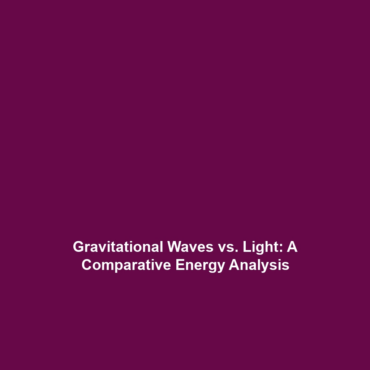How Gravitational Wave Energy Compares to That of Light and Other Forms of Radiation
Introduction
Gravitational waves have emerged as a groundbreaking phenomenon that challenges our understanding of the universe. These ripples in spacetime, predicted by Einstein’s General Theory of Relativity, carry energy across vast distances. By examining how gravitational wave energy compares to that of light and other forms of radiation, researchers can uncover vital insights into the universe’s most violent events. This exploration not only enhances our understanding of gravitational waves but also sheds light on fundamental principles of physics that govern all forms of radiation.
Key Concepts
Understanding the energy of gravitational waves in relation to light and other types of radiation involves several key concepts:
- Nature of Gravitational Waves: Gravitational waves are distortions in spacetime caused by accelerating massive objects, such as merging black holes or neutron stars.
- Energy Transfer: Unlike light waves, which are electromagnetic and can propagate through a vacuum, gravitational waves transfer energy through spacetime itself.
- Detection Methods: Instruments like LIGO (Laser Interferometer Gravitational-Wave Observatory) detect gravitational waves by measuring tiny changes in distance caused by these energy ripples.
- Comparison with Light: While both gravitational waves and light waves carry energy, their propagation through the universe occurs through different mechanisms, leading to different interactions with matter.
Applications and Real-World Uses
Understanding how gravitational wave energy compares to light and other forms of radiation has practical implications:
- Astrophysics Research: Insights gained from gravitational wave observations help study phenomena like black hole mergers and neutron star collisions.
- Cosmology: Gravitational waves provide a new way to investigate the universe’s expansion and the distribution of cosmic matter.
- Testing General Relativity: By comparing predictions of General Relativity with observational data from gravitational waves, scientists can test the limits of existing theories.
Current Challenges
The study of how gravitational wave energy compares to light and other forms of radiation faces several challenges:
- Sensitivity of Detectors: Current gravitational wave detectors are limited in their sensitivity and can only capture events that occur relatively close to Earth.
- Noise Interference: The presence of noise from the environment can complicate the detection of faint gravitational waves.
- Theoretical Models: Developing accurate models to understand and predict the behavior of gravitational waves remains an ongoing challenge.
Future Research and Innovations
Future innovations are expected to enhance our understanding of gravitational waves:
- Advanced Detectors: Newer detectors, such as the space-based LISA (Laser Interferometer Space Antenna), aim to detect a broader range of gravitational waves with greater sensitivity.
- Multi-Messenger Astronomy: Integrating gravitational wave observations with electromagnetic signals can provide a more comprehensive view of cosmic events.
- Theoretical Advancements: Continued research will likely improve our theoretical understanding of waveform models and their implications for gravitational wave astronomy.
Conclusion
Comparing gravitational wave energy to that of light and other forms of radiation reveals significant insights into the nature of the universe. The distinct properties of gravitational waves not only enrich our understanding of astrophysical phenomena but also open new avenues for research that challenge existing theories. As advancements continue, it becomes increasingly crucial for both scientists and enthusiasts to stay informed about developments in this exciting field. For further reading on gravitational waves and their impact on modern physics, check out our other articles on gravitational wave research and astrophysical applications.

Leave a Reply